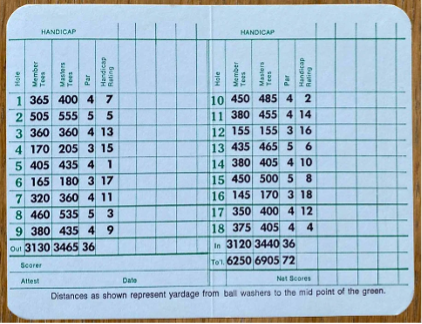The Masters | Nick Sahrmann
Introduction
In order to score well on the course, a golfer must understand their odds of hitting a successful shot. The same can be said at the card table. A player must be able to recognize the situation they are in, and how they can maximize each of their turns based on their odds.
You can play the odds in Card Golf Tour just like you can play the odds on the golf course. From week to week, we will share examples of pros playing the odds during the week’s professional golf tournament. Then we will review how you can play similar odds during your next round of Card Golf Tour.
Pro Example
This week’s edition of Playing The Odds is from the Masters at Augusta National Golf Club in Augusta, GA.
As Scottie Scheffler came to the 16th tee in the final round of the Masters he carried a small lead over a group of three competitors. He knew a birdie could all but seal his victory and earn his 2nd green jacket. He also knew that the 16th hole at Augusta is historically the easiest hole on the course.
Below is an image of an Augusta National scorecard, which shows hole 16 as the 18 handicap rating – meaning it is the easiest hole on the course.

With that rating in mind, Scheffler played his tee shot at the pin because he knew trouble is limited on the hole. Scheffler stuck his tee shot less than 10 feet from the pin and subsequently sank his putt for birdie – effectively sealing his Masters championship.
Card Golf Tour Example
In Card Golf Tour, an optional but recommended component of the game is the stroke index system. Card Golf Tour’s unique stroke index system makes holes/hands more or less difficult through the removal of better or worse cards respectively. The cards are removed from the deck before dealing to each player. The better cards in the deck (think Putter, Driver, Hybrid) are removed when the stroke index value is low. And the worse cards in the deck (think irons and wedges) are removed when the stroke index value is high.
As the 18 stroke index (or handicap rating) hole, the par 3 16th hole looks like this for Scheffler before play begins.
The 7 iron, 8 iron, 9 iron and Pitching Wedge are removed from the deck and placed on table for all players to see. Being worse cards, the removal of these cards from the deck makes the hand easier for all players.

Scheffler flips over card as his tee shot on the Par 3 16h hole…a 4 iron that puts him within birdie range.

After a couple of turns, Scheffler ‘s hand has a total point value of 1 point with one remaining card face down.

Playing the odds, Scheffler knows that the odds are lower that his remaining face down card will have high point values because it is the 18 stroke index hole and 4 of the highest point value/worse cards have been removed from the deck. He also knows that cards in the draw pile have better odds of being good cards.
On his final turn on the hole, Scheffler draws a 3 iron – which would give him a par. However, he knows that his face down card has a likelihood of being a good card given the stroke index of 18. So he discards the 3 iron and takes the chance of turning over his face down card.
His aggressiveness pays off as he flips over his face down card to reveal a -2 point driver – which gives him -1 point total in his hand and a birdie on the hole.
